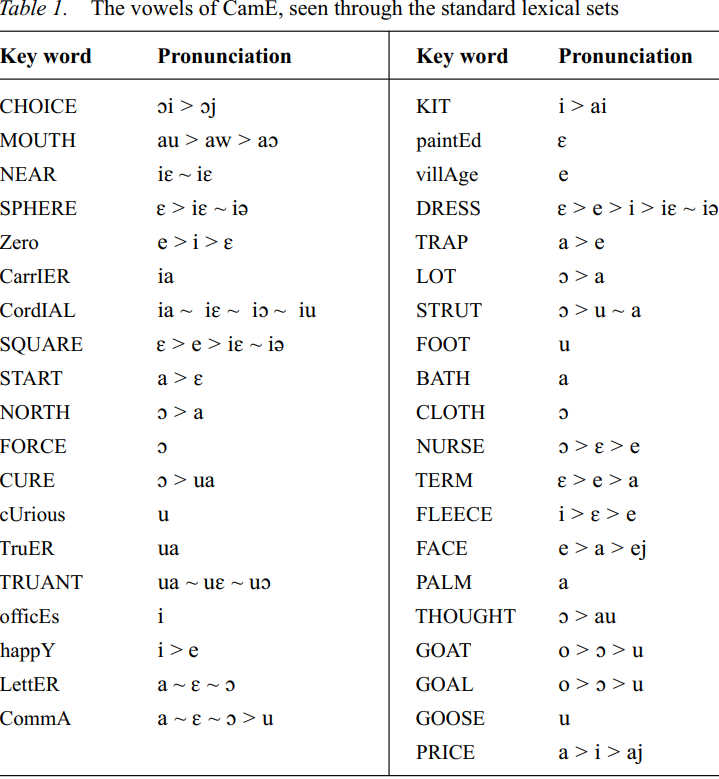


 Grammar
Grammar
 Tenses
Tenses
 Present
Present
 Past
Past
 Future
Future
 Parts Of Speech
Parts Of Speech
 Nouns
Nouns
 Verbs
Verbs
 Adverbs
Adverbs
 Adjectives
Adjectives
 Pronouns
Pronouns
 Pre Position
Pre Position
 Preposition by function
Preposition by function 
 Preposition by construction
Preposition by construction
 Conjunctions
Conjunctions
 Interjections
Interjections
 Grammar Rules
Grammar Rules
 Linguistics
Linguistics
 Semantics
Semantics
 Pragmatics
Pragmatics
 Reading Comprehension
Reading Comprehension|
Read More
Date: 2024-03-19
Date: 2024-04-30
Date: 2024-05-04
|
The spelling-induced /a/ is the most common realization of the commA vowel in CamE. When the vowel is represented by o, it is realized as /ɔ/; e.g. abb [ɔ] t, big [ɔ] t, Lenn [ɔ] n. CamE has a predilection for /i/ before final /n/ irrespective of the grapheme, as in Samps[i]n, Wils[i]n. /i/ is even more systematic in words which have an /i/ in the preceding syllable, as in hidd[i]n, Hilt[i]n, kitch[i]n, pris[i]n. This can be considered as a case of vowel assimilation or harmony. This phenomenon yields other vowels in other contexts, like [ç] in Rob [ɔ] rt and Thom [ɔ] s.
Seen through Wells’ lexical sets, and accommodating both Foulkes and Docherty’s (1999) addition as well as the modifications suggested by the split observed in CamE phonology, the vowels of CamE can be summarized as in Table 1.

From the above picture, a seven-vowel system ([i, e, ε, a, ɔ, o, u]), plus a marginal schwa, appears. The marginal nature of the schwa is due to its extremely low frequency. It normally occurs only as the second member of the NEAR diphthong in acrolectal speech, and in epenthetic environments like [ebəl, riðəm, kapitalizəm] able, rhythm, capitalism. The low frequency of the schwa is mostly due to the fact that CamE generally does not apply the Vowel Reduction rule.
Of particular interest in the discussion of the patterns of realization of the standard lexical sets has been the phenomenon of splits (e.g. of the NURSE and CURE vowels) and mergers (e.g. of the LOT, THOUGHT, NORTH, FORCE and STRUT vowels). The splits are responsible for the splitting of some pairs which are homophonous in RP, like dollar/dolour [dɔla, dɔlɔ] , fisher/fissure [fiʃa, fiʃɔ] word/ whirred [wɔd / wɔt , wεd / wεt], swab/swob [swab/swap , swɔb,swaɔp], kernel/colonel [kεnεl , kɔlɔnεl]. The mergers create new homophones in CamE, like match, march [matʃ] , talk, thug [tɔk] , circular/secular [sekula], fodder, further [fɔda] , hod, hud, hoard [hɔd/hɔt]. A more comprehensive list of such splits and mergers can be found in Simo Bobda (1994: 157–161).
The discussion has also highlighted, beyond mere cases of segment restructuring, some vocalic processes like E-Tensing, Glide Formation, i-Assimilation, as well as the behavior of CamE with regard to some RP rules like Vowel Reduction, CiV Tensing and Trisyllabic Laxing.
|
|
|
|
كيف تساهم الأطعمة فائقة المعالجة في تفاقم مرض يصيب الأمعاء؟
|
|
|
|
|
|
|
مشروع ضخم لإنتاج الهيدروجين الأخضر يواجه تأخيرًا جديدًا
|
|
|
|
|
|
|
المجمع العلمي يختتم دورته القرآنية في فن الصوت والنغم بالطريقة المصرية
|
|
|